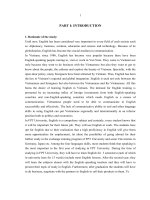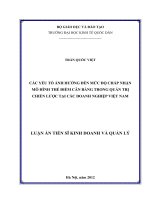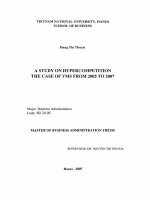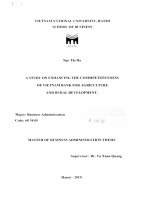A study on hypercompetition the case of VMS from 2005 to 2007 : Luận văn ThS. Kinh doanh và quản lý: 60 34 05
Bạn đang xem bản rút gọn của tài liệu. Xem và tải ngay bản đầy đủ của tài liệu tại đây (24.7 MB, 77 trang )
VIETNAM NATIONAL UNIVERSITY, HANOI
SCHOOL OF BUSINESS
Dang Thi Thuyet
A STUDY ON HYPERCOMPETITION
THE CASE OF VMS FROM 2005 TO 2007
Major: Business Administration
Code: 60 34 05
MASTER OF BUSINESS ADMINISTRATION THESIS
SUPERVISOR: DR. N G U Y E N THI PHI NGA
Hanoi - 2007
TABLE OF CONTENT
Pages
Sub cover page
Table o f content
List o f abbreviations.
List o f Figures
1
INTRODUCTION
CHAPTER 1: THEORY FOUNDATION
1.1.
Introduction
5
1.1.1. The definition o f Hypercompetition
5
1.1.2. Competitive advantages in Hypercompetition
6
1.1.3. Levels of competition within an industry
7
1.2. Four Arenas in Hypercompetition
1.2.1. Cost & Quality
9
9
1.2.2. Timing & Know-how
11
1.2.3. Strongholds
13
1.2.4. Deep pocket
16
1.3. New 7S’s Model
18
CHAPTER 2: MOBILE SECTOR AND VMS ANALYSIS
2.1. Competition analysis on Mobile market from 2005-2007
2.1.1. Vietnam’s Mobile market
21
21
2.1.1.1.
Overview
21
2.1.1.2.
Mobile structure
22
2.1.1.3.
Regulations
23
2.1.1.4.
Operators
24
2.1.1.5.
Technologies
25
2.1.1.6.
Market situation
27
2.1.1.7.
Forecasted growth
29
2.1.2. Mobile market competition
31
2 .1.2.1.
Cost & Quality Arena
35
2.1.2.2.
Timing & Know-how Arena
37
2.1.2.3.
Strongholds Arena
38
2.1.2.4.
Deep-pocket Arena
38
2.1.3. Conclusion on Mobile Market
2.2. Analysis o f the VMS’s Competitive ability in 2005-2007
38
39
2.2.1. VM S’s Overview
40
2.2.2. VM S’s competitive ability
40
2.2.2.1.
Organization
40
22.2.2.
Business culture
41
2.2.2.3.
Infrastructure
42
2.2.2.4.
Human resource
43
2.2.2.5.
Financial
43
2.22.6.
Products
44
22.2.1.
Marketing and Sales
45
2.2.2.8.
Forecasted Growth
47
48
2.2.3. Conclusions on VMS
CHAPTER 3: RECOMMENDATIONS
3.1. For Vietnamese authority
50
3.2. For VMS
51
3.2.1. New 7S’s Model
51
3.2.2. Action plan
55
CONCLUSION
58
REFERENCE
59
APPENDIX
ii
LIST OF ABBREVIATIONS
TECH: technology
MBA: Master of Business Management
ID: Identify
WTO: World Trade Organization
BTA: Bilateral Trade Agreement
BCC: Bilateral Corporation Contract
FDI: Foreign Direct Investment
ROA: Research Group on Asia
HCM: Hochiminh City
VMS: Vietnam Telecom Mobile Service Company
SPT: Saigon Post Tel
VIETTEL Mobile: V1ETTEL Mobile Corporation
HANOI TELECOM: Hanoi Telecom Corporation
VP TELECOM: Vietnam Power Telecom Coiporation
GPC: Telecommunication Service Company
MPT: Ministry' of Posts and Telecommunication
VNPT: Vietnam Post and Telecom Corporation
SMP: Signified Market Power
GSM: Global System for Mobile Communication
CDMA: Code Division Multiple Access
BTS: Base Transceiver Station
WAP: Wireless Application Protocol
3G: 3 generation
NGN: Next Generation Network
SMS: Short Message Service
R&D: research and deploy
TV: Television
PR: Public relation
ix
LIST OF FIGURES
Figure 1.1: A series of short-lived actions add up to a sustained
Page: 06
advantage.
Figure 1.2: Different level of competition within an industry.
Page: 07
Figure 1.3: Different strategies in cost-quality arenas.
Page: 09
Figure 1.4: The
cycle of timing/know-how competition.
Page: 11
Figure 1.5: The
cycle of turf battles an entry barrier competition
Page: 14
Figure 1.6: The
cycle of competition in the deep pockets arena
Page: 16
Figure 1.7: Disruption and the New 7S’s Model
Page: 18
Figure 2.1: Vietnam’s Telecommunication structure
Page: 22
Figure 2.2: The
suppliers of Vietnam Mobile Market
Page: 24
Figure 2.3: The
subscriber growth of Vietnam Mobile Market
Page: 27
Figure 2.4: The
revenue growth of Vietnam Mobile Market
Page: 28
Figure 2.5: The
Mobile Penetration Growth
Page: 29
Figure 2.6: The
Mobile market share in the first quarter of 2007
Page: 29
Figure 2.7: The
subscriber growth of Vietnam Mobile Market
Page: 31
Figure 2.8: The
Vietnam Mobile Market Share 2005-2007
Page: 33
(subscribers)
Figure 2.9: The Vietnam Mobile Market Share 2005-2007
Page: 34
(revenue)
Figure 2.10: History of Vietnam Mobile sector in each of the
Page: 36
four arenas
Figure 2.11: History of Vietnam Mobile sector in Pirce-Quality
Page: 37
arenas
Figure 2.12: Organization structure of VMS
Page: 41
Figure 2.13: The network coverage of MobiFone
Page: 43
Figure 2.14: Revenue-Cost-Profit of VMS
Page: 44
Figure 2.15: MobiFone’s Market share growth
Page: 46
*
Figure 2.16: The choice of current customers when renewing
Page: 47
Figure 2.17: The choice of new customers
Page: 47
Figure 2.18: VMS' Development Forecast
Page: 48
Figure 2.19: The Forecast of technology development in VMS
Page: 48
Figure 2.20: The comparison of VMS’ competitiveness
Page: 50
Figure 3.1: The suggestion New 7S's Model for VMS
Page: 54
Figure 3.2: The suggestion action plan for VMS
Page: 58
xi
INTRODUCTION
1.
Problems:
The Vietnam mobile market’s competition is increasing and now VMS
is loosing its market share and its brand name preference in customer
perception. We can see that VMS’s competitive ability is decreasing.
Therefore, How VMS can keep its leading position and compete with its
rivalries?
2.
Objectives & Aim
Objectives
-
Study on the Hypercompetition (4 arenas and New 7S’s Model)
-
Competition analysis on Mobile market from 2005-2007
-
Analyze the VMS’ competitiveness.
-
Application New 7S’s Model to VMS case.
Aim
-
Give out the applicable and effective competitive strategy and action
plan to improve the VMS competitive capacity.
3.
Research questions
In order to achieve the objectives o f the thesis, the author of thesis will
try to answer the following questions:
- What is the VMS’ competitive capability in 2005-2007?
- How is the competition in Mobile sector in 2005-2007?
- How is the new 7S’s Model of VMS?
1
Method/Approaches
- Empirical research/Case study method
- Approaches: statistics
Scope o f w ork
- VMS 2005-2007
- The competition in Mobile sector
Data resources and processing
Data Resources
- Secondary Source: Report and Data o f VMS and its competitors
- Tertiary
Richard
Source:
D ’Aveni
and
RobertGunther,
Hypercompetition. 1994. Free Press, Grahan J. Hooley, John A.
Sauders,
Nigle
F.
Pierry,
Marketing
strategy
&
Competitive
positioning. 1998. Prentice Hall Europe
Data Processing
Data Processed by excel, chart to summary, compare and analyze
Significance
- Theory: Introduce the significant theory to VN
- Reality: Bring more competitive advantages to VMS
Limitations
- This research only focuses VMS and the data is 2005-2007. It is may
be changed in future.
9.
Expected results
-
Knowledge
in Hypercompetition
and Vietnam’ Mobile Market
competition
10.
Dissem ination
11.
What is VM S’ strength and weakness comparing with its rivalries.
This research can be studied further for service sectors
Follow-up potential
How VM S’s competitive capability is improved if applied these
recommendations? The checking and adjusting will be done if needed
12. Thesis structure
This thesis is divided into three parts included theory foundation,
Mobile sector and VMS analysis and recommendations.
Chapter 1: Theory foundation
The Hypercompetition theory of D ’Aveni (1994) is reviewed in this
chapter by some main parts such as: definition, advantages, four arenas and
New 7S’s Model. The thesis will discuss on this theory. The New 7S’s Model
will be applied to suggest suitable solution for VMS to enhance its
competitiveness.
Chapter 2: M obile sector and VMS analysis
The statistic data and analysis by hypercompetitive view will give the
deep and detail picture o f Mobile sector as well as its competition battles in
3
the past. Moreover, we can see how VMS is strong or weak in the
competition.
Chapter 3: Recomm endations
Based on the analysis and found reasons in theory application, some
suggestions are delivered to Vietnam Government to build an motivative
business environment and the New 7S’s Model will be given out to improve
VMS’ competitiveness.
4
CHAPTER 1: THEORY FOUNDATION
1.1.
Introduction
1.1.1. The definition o f Hypercompetition
The economic environment is changing to the new knowledge
economy. It leads to Scope of competition changing from Local to Global
with hypercompetition and make the new Competition Rule - “the fast eats
the slow” instead the old “The big eats the small”. The Hypercompetition is
bom in this context in USA, 1994 by Richard D ’Aveni. The author is the
professor o f strategic management and now he is coordinator o f the strategy
and technology group at the Tuck school.
The Primary issue o f Hypercompetition is “creative destruction”.
“Creative destruction” refers to the fact that innovation creates new
opportunities o f profit while destroying competitor’s advatage.
The definition of Hypercompetition is [D'Aveni, 1994, p. 217-218]
Hypercompetition is an environment characterized by intense and
rapid competitive moves, in which competitors must move quickly to
build advantages and erode the advantages o f their rivals. This
speeds up the dynamic strategic interactions among competitors.
Hypercompetitive
generating
new
behavior
is
competitive
the process
advantages
o f continuously
and
destroying,
obsolescing, or neutralizing the opponent's competitive advantage,
thereby creating disequilibrium, destroying perfect competition, and
disrupting the status quo o f the marketplace. This is done by firm s
moving up their escalation ladders faster than competitors,
restarting the cycles, or jum ping to new arenas.
5
It shows that D ’Aveni is basing his theory o f Hypercompetition on a
Schumpeterian idea o f competition.
1.1.2. Competitive advantages in Hypercompetition
FIGURE 1.1
A SER IES OF S H O R T -L IV E D A C T IO N S A D D U P TO
A S U S T A IN E D A D V A N T A G E
[D'Aveni, Hypercompetition, 1994, p. 12]
D ’Aveni(1994) is aware that today’s companies are fast at copying
each other’s advantages. Therefore, the advantage is only temporary, but if
you are constantly innovative you will have temporary advantages all the
time, which is then a sustainable competitive advantage. In this context, the
company is not seeking for a sustainable advantage.
The primary goal o f this strategy is to disruption the current situation in
order to seize the initiative through creating a series o f temporary advantages.
In cased o f the shortened competitive cycles, it is necessary to rapidly develop
6
new advantages. It has become more important for the company to focus on
generating their next advantages even before their current advantages eroded.
By this way, the company can keep one step ahead o f its rivalries,
moving from one temporary advantage to the next.
1.1.3. Levels o f competition within an industry.
Low
Intensity
M oderate
C om petition
— ►Competition
• No
com petition
• M onopoly
• Legal
m onopoly through
patent
• E xcessive
profits
are
sustainable
for
years
•
High Intensity
--------------- ►Competition
C om petition A voidance
•
• Firm position around each
other but not directly against each
other
Sustainable Profits
• Perfect
com petition
• A ll four o f the
com petitive advantages
have been elim inated so
the players are equal in
all four arenas.
• Firms
create
new
com petitive advantages w hich
make
ob solete
or
match
opponents’ advantages in one
or more o f the four arenas.
• Firm com pete
in price until no one
make abnormal profits.
• Norm ally,
perfect com petition is
not
preferred
over
lower
levels
of
com petition
because
lowers
levels
of
com petition
lead
to
more opportunity for
profits
• Firms attempt to stay
ahead o f their com petitors in
one or more o f the four arenas.
• Firms
create
new
com petitive advantages that
make
the
op pon en ts’
advantages
irrelevant
by
m oving to com pete in another
arena.
• Long-term
sustainable
advantage and profits are possible,
but on ly as long as all the
com petitors cooperate or respect
the entry barrier
E xcessive Profits
Hypercom petition
• Firms
aggressively
position against one another
by attempting to disadvantage
opponents
• Segm entation o f markets
occurs so there is only one player
in each segm ent
• Barrier to entry are used
to lim it entry o f markets by
com petitors.
• If som e sm all degree o f
segm ent/niche
overlap
occurs,
firm s tacitly cooperate to restrict
this overlap or restrain com petitive
behavior.
The t r e n d s _______ ^
M onopoly
O ligop oly
(O ne Player)
(Sm all number o f players)
Extreme
— ►Competition
• Temporary
advantages and short periods
o f profits are achievable until
com petitors catch up with or
outm aneuver the aggressor’s
last com petitive m ove.
^
^
Schumpeterian C om petition
(Several players)
Intermittent/Low Profits
Perfect Competition
(M any players)
N o Abnormal Profits
FIGURE 1.2
DIFFER EN T LEVELS OF C OM PETITION W ITHIN A N IN D U STR Y
[D'Aveni, Hypercompetition, 1994, p. 28]
7
D ’Aveni defined the competition into four level with the number o f
players increasing relatively. Firstly, the low intensity competition or
Monopoly brings the excessive profit to one player in this field.
Secondly, the moderate competition or oligopoly is more competitive
level o f some players. But incase each player take over one different segment,
it is still monopoly in segment. In this level, the company can get the
sustainable profits.
Thirdly, the hypercompetition with several players is more popular in
this decade in Vietnam. All firms can make intermittent profits by taking
short-lived actions and moving from the first to the fourth arenas with
different levels.
Fourthly, the extreme competition or perfect competition is the highest
level o f competition between many players. No one wants to move this stage
because o f no abnormal profit.
Base on this figure, the company can know where is your industry
stand how is its next move. The competitive strategies will be defined
relevantly with each level’s characteristics.
8
1.2.
Four Arenas in Hypercompetition
1.2.1. Cost & Quality
L*: Low-cost producer position
D*: Differentiator position
E4*: All firms at industry’s creation
FIGURE 1.3
DIFFERENT STRATERGIES IN C O ST-Q U A L ITY A R E N A S
[D'Aveni, Hypercompetition, 1994, p. 50,55,58]
This is the overall picture o f all competitive strategies in the costquality arena. The first point o f arena is E4 - the industry’s creation. Then
9
based on the company’s strategy, they move to the D* or L*. In this case,
each company comes to each segment.
But in sub arena, the consumer’s behavior may be changed such as, the
high-end customers still want to get the less price with the same or even
higher quality and the low-end need to use the higher quality product without
paying more money. So its rivalries could jum p into D ’ or L ’.
Based on the gaps between each segments from L* to D*, the current
or new competitors can enter them by niching opportunities or flaking
position. This is the full line producer strategy o f current rivalries or nichemarket entrance strategy o f new comers. This forces the existing competitors
to respond by offering better values to the customers with lower price, higher
quality or both.
However, the aggressive firms find that it can be difficult to simply
move up or down into the markets o f the full-line producer unless they can
offer better in terms o f price or quality to customers than the full-line
producers. This leads to the next dynamic strategic interactions: the move
toward Ultimate Value.
10
1.2.2. Timing and know-how
FIGURE 1.4
THE CY CLE OF TIM IN G /K N O W -H O W COM PETITION
[D'Aveni, Hypercompetition, 1994, p. 108]
11
The first mover starts the cycle by create its advantages based on
technological recourse. The company bases on this to move in to new market.
The followers escalate the conflict by imitating the new product. The pioneer
goes further by throwing up obstacles to keep the followers from imitating
subsequent products. Once again the followers escalate by overcoming the
obstacles and replicating the resource base o f first mover. At this point, some
first movers use the leap-frog strategy to keep the first position by creating the
new cycle with the higher risks and greater cost. Sometimes, they apply the
transformation strategy in stead of leaf-frog one.
By this strategy, they can compete with later comers by replicating
their recourse base o f process know-how and low-cost manufacturing
methods. The transformation strategy leads to a price war and the leap-frog
strategy makes risks and costs that are greater than the rewards. Moreover, the
pioneer can also use the vertical integration to gain temporary advantages
over competitors.
This way is can be imitated and creates a complex and no adaptable
organization. It makes the firm vulnerable to more flexible, less integrated
competitors. Two or more resource based can be used at the same time. Also
some companies skip steps along this ladder or end up frozen at one rung
temporarily. In general, this is the full picture o f typical process. But
competitors will climb up this ladder in many different ways. In this arena, we
see that how pioneer and followers maneuver against each other to move
ahead on the escalation ladder with new product introductions and new
generations o f products. We have also seen how these maneuvers speed up
over time and get bolder.
Hypercompetitive firms attempt to avoid or break out o f perfect
competition (no one has an advantage) by speeding up the ladder faster than
12
the other players or restarting the cycle by building new knowledge bases that
allow new products and business methods to be used.
1.2.3. Strongholds
The root o f this arena’s analysis is Michael Porter’s Five Force Model.
In the Porter’ Model, he mentioned about “threat o f new entrant”- prevented
by entry barrier. This model is used popularly in consulting firms, strategic
department and MBA as analytic tool to identify how the firm can reduce the
aggressiveness o f rivalry, the power o f buyers and suppliers, and the threat of
entrants and substitutes.
However, as competitors have become more aware o f the strategic
importance o f entry barriers and as market becomes more dynamic,
companies have become more creative and aggressive in circumventing entry
barriers. According to Porters, there are seven entry barriers: economies o f
scale, product differentiation, capital investments, switching costs, access to
distribution channels, cost disadvantages other than scale and government
policy.
Base on this view, D’aveni said “to overcome the above entry barriers,
entrants often rely on synergies with their other businesses and acquisitions to
break into strongholds”.
13
FIGURE 1.5
THE CYCLE OF TURF BA TTLES AND ENTRY BARRIER COMPETITION
[D'Aveni, Hypercompetition, 1994, p. 145]
14
The figure 1.5 shows the erosion o f safe havens following the
escalation ladder. Both the incumbent and the entrant initially build barriers
around their strongholds.
The entrant launches an attach into the incumbent’s market with tactics
designed to delay the incumbent’s response. At the first time, the new comers
always get the accommodating from the incumbent. But sometimes, the reply
is a fierce attack. Ultimately, all incumbents respond to serious attacks by
using their current advantages in the entry barrier that they have been created.
The new comers should overcome these barriers and take the market share or
start a price war in the incumbent’s market. Then the incumbent attacks the
entrant’s home market. Finally, both strongholds are eroded or merge in to
one market.
15
1.2.4. Deep pockets
FIGURE 1.6
THE CYCLE OF COMPETITION IN THE DEEP POCKETS ARENA
[D'Aveni, Hypercompetition, 1994, p. 174]
16
It is the evident truth that deep pockets are a vita strategic weapon. But
they do not last forever. As the above chart, clever competitors can
circumvent a deep-pocket advantage. Even firm with the deepest pockets has
limits to how much it can throw its weight around without self-destructing
because o f customer or supplier reactions.
The firm with substantial resource has great opportunities and the
support on competitors. But if “the rich-resource firm” does not have a clear
path to success, “the street-smart small firm” can end up the deep pockets’
strategy and push the competitive conflict up the escalation ladder as the
figure 1.6. Thus, a deep-pocket advantage is not sustainable forever.
The cycle begins when a firm with deep pockets launches an offensive
against its smaller competitors in order to kick them out o f the industry. The
small firms counter by asking antitrust laws or other forms o f government
intervention. If not, they are forced to try to outmaneuver the large firm by
animosity takeover by any resource bases, cooperative strategies or avoidance
through niching other approaches.
This model o f deep pocket advantage is static. It assumes that battles
can be won or lost by accounting up the level of resource of each player at a
given moment in time. But sometimes a small competitor can neutralize the
advantage o f the deep-pocket company. By dynamic maneuvering, relatively
small company can defeat a large one and in the process become a large firm
with its own deep pockets. In addition, alliances can be built to add to the
resources o f small players.
To end this level o f hypercompetition, some firms may again try to gain
an “even-deeper-pocket advantage”. Through, alliances and merges, one firm
or another will try to get the upper hand, restarting the deep-pocket cycle all
over again.
17
ĐẠI H Ọ C QUỐC G ia h ả Mọ
TRUNG TÂM THÔNG TIN THƯ VIỆN
A - LQ i .ÀQ
1.3.
New 7S’s Model
Vision for Disruption
Identifying and
creating
opportunities for
tem porary
advantage via
understanding
•Stakeholder
Tactics fo r Disruption
Seizing the initiative
to
gain advantage by
m om entum by
developing abilities
for:
• Shifting the rules
• Speed
• Signaling
• Surprise
• Strategic thrusts
that can be applied
across
m any actions to build
a series o f tem porary
with actions that
shape,
m ould or influence
the direction or nature
a d v a n ta g e s
FIGURE 1.7
D ISR U PTIO N A N D THE N E W 7 S ’s M O DEL
I
[D'Aveni, Hypercompetition, 1994, p. 258]
D ’Aveni (1994) is explaining seven points that enables a firm to deal
with a Hypercompetitive environment.
18









